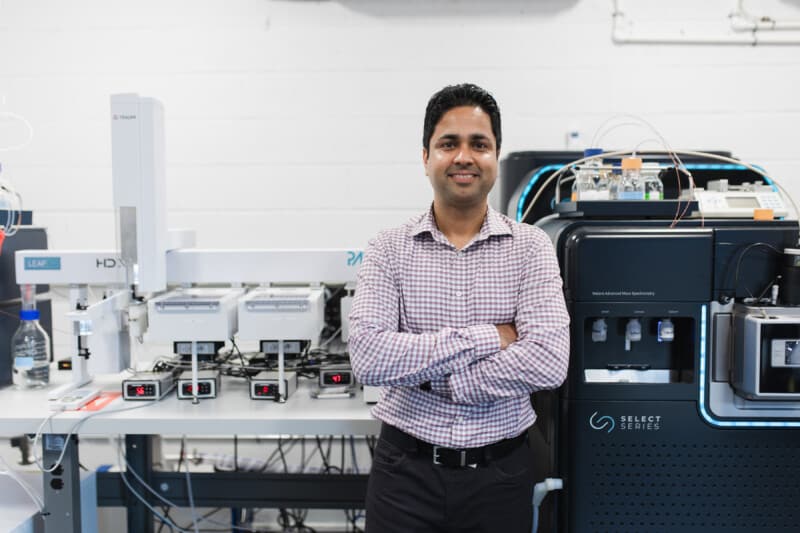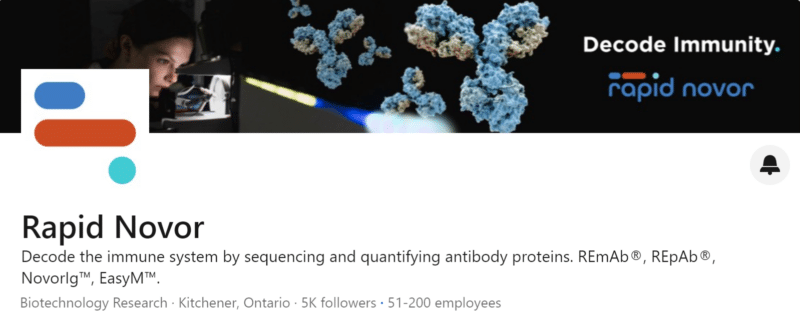Dr. Dominic Narang is a Senior Scientist & Manager of HDX-MS epitope mapping services at Rapid Novor, bringing over 7 years of experience in structural biology and mass spectrometry.
He specializes in providing solutions to biotechnology and pharma companies for their drug discovery and development platforms using Hydrogen-Deuterium Exchange Mass Spectrometry (HDX-MS), a powerful tool for characterizing antibody-antigen interactions.
What first sparked your interest in mass spectrometry, proteomics, and structural biology?
My interest in structural biology was initially sparked during my master’s program, where I studied phenotypes of yeast cells expressing prion proteins. While my work at the time was limited to phenotypic analysis, I was curious about the structural biology of disordered proteins and amyloid fibrils.
This curiosity led me to pursue a Ph.D. in structural biology, where I investigated the structure of amyloid fibrils using various biophysical techniques, including fluorescence spectroscopy and atomic force microscopy. While these tools provided valuable insights, they did not offer a complete, dynamic, and high-resolution picture of amyloid fibrils at the amino acid level. This limitation was frustrating; I had invested so much time in experiments, yet the structural details remained incomplete.
During my Ph.D., I attended a conference where a researcher, who would later become my future postdoctoral advisor, gave a presentation on hydrogen-deuterium exchange mass spectrometry (HDX-MS). The presentation demonstrated how HDX-MS reveals high-resolution, dynamic insights into protein structure and interactions. Inspired by this, I decided to focus my research on HDX-MS, exploring protein dynamics, structure, and interactions.
The Nobel Prize award to Dr. Baker and Alpha Fold shone the spotlight on computational approaches to structural biology. How do you think structural biology will evolve and what role will experimental approaches play?
The Nobel Prize awarded to Dr. Baker for Alphafold signified the potential of computational approaches in structural biology. Computational methods are becoming increasingly popular for their time efficiency and cost-effectiveness. For example, it’s not uncommon to take up to a year to get X-ray crystals and collect high-quality, three-dimensional crystallography data. Computational approaches can answer these questions much faster than crystallizing a protein. This capability significantly accelerates structural biology by providing visualizations of proteins for which no experimental structures are currently available.
Looking ahead, structural biology will continue evolving into a more integrated field where experimental and computational methods complement each other. Instead of relying on either approach in isolation, researchers will merge the strengths of both, leading to more robust and accurate structural insights. Our case study with mAbSilico highlights this in action, demonstrating the integration of AI and HDX-MS for antibody epitope mapping.
Cross-talk between computational and experimental data is essential in both directions. In HDX-MS experiments, extensive optimization is required to achieve the most accurate, reproducible, and high-coverage data. Computational epitope mapping predictions can help narrow potential antigen-binding sites, allowing a more targeted experimental approach to maximize resolution in these regions.
At the same time, high-quality experimental data is essential for refining computational models. The feedback loop between experimental and computational approaches will continue to enhance both fields, enabling more precise protein structure predictions and efficient experimental design.

Can you briefly explain HDX-MS as a tool for exploring protein structure and interactions?
HDX-MS is a powerful tool for studying protein structure, dynamics, and interactions. It works by measuring the exchange of hydrogen atoms in the protein backbone with deuterium from the solvent. This exchange is influenced by factors such as hydrogen bonding, solvent accessibility, and protein conformation, providing insights into structural changes and binding interactions. Differences in deuterium uptake can reveal epitope locations and allosteric effects.
The workflow involves labeling the protein with deuterium, quenching the exchange, digesting it into peptides, and analyzing it using mass spectrometry, following a bottom-up approach to extract structural information at the protein level.
For a review on how HDX-MS works for antibody epitope mapping, visit our article: What is HDX-MS?
How does HDX-MS compare to other epitope mapping techniques, and when would you choose it over others?
HDX-MS is a highly informative tool for studying protein dynamics and interactions. Unlike X-ray crystallography or cryo-EM, which give you static, high-resolution structures, HDX-MS excels at capturing conformational flexibility and dynamic changes. That makes it particularly useful when investigating how a protein changes upon binding or mapping epitopes involving structural rearrangements.
One of the significant advantages of HDX-MS is that it works under near-native conditions, so you’re preserving biologically relevant interactions—something that can be challenging with crystallography. It’s also an excellent option for proteins that are difficult to crystallize or too large for NMR.
While HDX-MS does not provide atomic-level resolution like X-ray or cryo-EM, its ability to capture structural flexibility makes it a valuable complementary technique in epitope mapping and protein characterization.
Resolution depends on what you’re trying to achieve. If you need atomic-level detail, X-ray crystallography or cryo-EM would be the way to go. But suppose your goal is to understand structural flexibility, conformational changes, or epitope/paratope mapping. In that case, HDX-MS provides peptide-level resolution, often more than enough for epitope mapping and protein characterization. In many cases, combining HDX-MS with other structural techniques gives you the most complete picture.
For a comprehensive review on different epitope mapping techniques, and how HDX-MS compares, visit our article: Comparing Epitope Mapping Methods.
What recent advancements in HDX-MS are you most excited about, and how do you see these shaping the field over the next decade?
One major development is the growing use of microfluidics and automation in HDX-MS workflows. Traditionally, HDX-MS experiments have been performed manually, which can lead to reproducibility challenges. Automation not only reduces variability but also allows for 24/7 operation, increasing throughput and reducing sample consumption. During my postdoc, robotic handling of HDX-MS samples was challenging, but recent improvements have made automated systems far more reliable and efficient. As automation becomes more widespread, HDX-MS will become more streamlined and accessible.
Ion mobility separation is another exciting advancement. By integrating ion mobility into mass spectrometry, we can better separate deuterated peptides, improving resolution and making it possible to analyze larger proteins. This expands the range of biological questions that HDX-MS can address.
Looking ahead, one of the most promising frontiers for HDX-MS is its application in clinical research and personalized medicine. While HDX-MS has not yet been widely adopted in clinical settings, it has the potential to analyze mutant proteins in the presence of therapeutic drugs. This could provide a mechanistic understanding of how drugs interact with specific protein variants, paving the way for more targeted therapies.
How has HDX-MS contributed to unexpected discoveries in antibody therapeutics or structural biology?
HDX-MS has significantly contributed to unexpected discoveries in antibody therapeutics and structural biology by revealing cryptic epitopes and allosteric sites that may not be apparent through traditional structural techniques.
HDX-MS not only provides insights into antigen-antibody epitopes and paratopes but also detects structural changes upon binding, providing crucial insights for antibody engineering and drug development. In a 2021 study published in JASMS, we leveraged HDX-MS to analyze receptor binding to hACE2, uncovering two peripheral sites adjacent to the main binding site-potential neutralization hotspots. These allosteric regions serve as key targets for antibody therapeutics, offering novel strategies for therapeutic design.
HDX-MS has also been applied to studying extracellular domains and small-molecule interactions. Small-molecule binding studies can be challenging if the small molecule interacts only with amino acid side chains. Therefore, AI-based modeling is emerging as a complementary tool to predict and refine binding site identification.

Published February 20, 2025
Learn More About Our Epitope Mapping Services
RapidHDX-MS™ is our mass spectrometry-based epitope mapping service, designed to identify an antibody’s binding site on its target antigen with the highest accuracy and resolution. This service enables the analysis of complex interactions and the identification of both linear and conformational epitopes.
For more resources and case studies on HDX-MS for epitope mapping, please visit:
- Integrating AI and HDX-MS for Antibody Epitope Mapping
- Epitope Mapping: Alanine Scanning Mutagenesis vs. HDX-MS
- Confirming the Binding Site Between Cellular DNA Repair Proteins with HDX-MS
- Alpaca Antibody Discovery and Characterization with Polyclonal Sequencing, SPR and HDX-MS
If you have a question for Dominic about how HDX-MS could be useful in your work, please contact us to learn more!
Talk to Our Scientists.
We Have Sequenced 10,000+ Antibodies and We Are Eager to Help You.
Through next generation protein sequencing, Rapid Novor enables reliable discovery and development of novel reagents, diagnostics, and therapeutics. Thanks to our Next Generation Protein Sequencing and antibody discovery services, researchers have furthered thousands of projects, patented antibody therapeutics, and developed the first recombinant polyclonal antibody diagnostics.
Talk to Our Scientists.
We Have Sequenced 9000+ Antibodies and We Are Eager to Help You.
Through next generation protein sequencing, Rapid Novor enables timely and reliable discovery and development of novel reagents, diagnostics, and therapeutics. Thanks to our Next Generation Protein Sequencing and antibody discovery services, researchers have furthered thousands of projects, patented antibody therapeutics, and ran the first recombinant polyclonal antibody diagnostics


